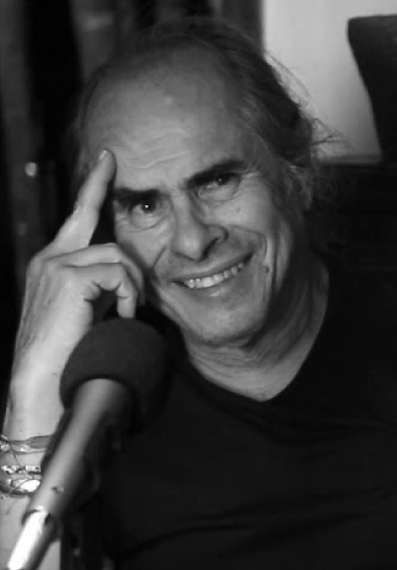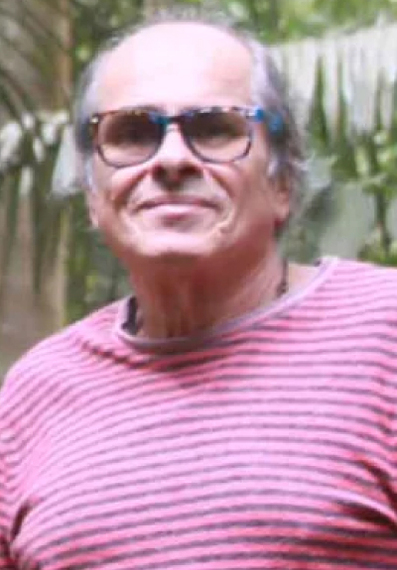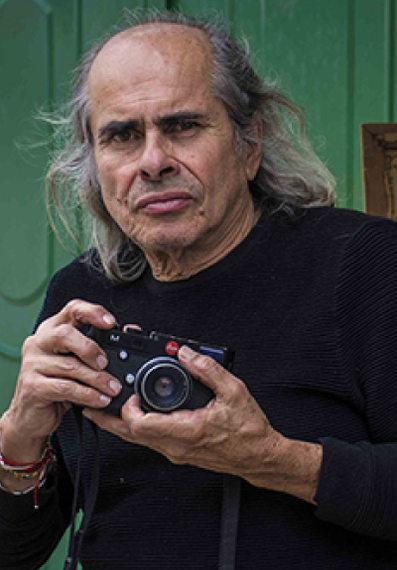Still photography, Assistant director
Eduardo Carvajal
A native of Cali, born "in the first half of the 20th century", stands out as the only photographer to document key moments in the history of Colombian cinema. His journey began inadvertently during the unfinished production of Angelita y Miguel Ángel in 1971. From there, he captured moments from films such as La mansión de Araucaima (The Mansion of Araucaima), Carne de tu carne (Flesh of Your Flesh), and Carlos Mayolo's Agarrando pueblo (Carching people).
Reflecting on his experiences, he told PANTALLA COLOMBIA a few years ago: "Among the shootings that really impacted me was Angelita and Miguel Ángel, maybe because it was my first job in a movie. I started by carrying the tripod, and that's when I discovered my ability to capture work moments. That passion for still photography began right then, as I was a photographer." He emphasized the importance of Agarrando pueblo in his career, saying, "The second most important work in my life as a still photographer was Agarrando pueblo, considering it was a documentary addressing an essential subject during a critical phase for Colombian documentary filmmaking. Apart from being behind the camera, the movie resonates with me the most in every way."
Beyond the film sets, Carvajal extensively photographed the personalities involved, especially those associated with the Cali Group. In particular, he captured the last iconic images of writer Andrés Caicedo shortly before his death at the San Fernando Theater, home to the now-defunct Cali Cineclub. In November 2023, he published Un Mundo de Andrés Caicedo (A World of Andrés Caicedo), a photo book that presents 145 selected photographs from the over 35,000 negatives stored in his archives.
"I wish there could be more consistency in the work of still photography, almost obligatory as I believe is done in other countries. Here, directors and producers don't give it importance, so friends end up doing that job (shooting tourists), and there is no continuity. I wish we could do other things. Still photography is exciting because you have freedoms. It's almost criminal behavior in the shooting. You see everything; you hear everything. It's voyeurism one hundred percent," he says about his profession.
He has had numerous exhibitions in cities such as Bogotá, Medellín, Cartagena, and Cali. Among the most notable are the XXII Salón de Arte Fotográfico (1996), the Marché du Cinema at the Cannes Film Festival (1998), the 41st Salón Nacional de Artistas (2008), the first Cali International Film Festival (where he would return in 2022), the 8th Festival Internacional Cine en las Montañas (2023), and the 21st edition of the Bogotá Short Film Festival - Bogoshorts, which honored him. "It's hard to think of a role that La Rata hasn't played in over 50 years in cinematography: extra, box-office clerk, location scout, messenger, actor's coach, among others. But his outstanding recognition, nationally and internationally, is as a still photographer. His archive, housing over 20,000 Colombian film negatives, stands as one of Colombian cinema's greatest assets," said the event.
The tribute also included screenings of restored versions of some of the first short films he made. These screenings were made possible thanks to the support of Proimágenes Colombia, Cinemateca de Bogotá, Lina González, and Bruma Cine. Among them was Fotofijaciones: Retrato hablado de Eduardo Carvajal (Photofixations: Spoken portrait of Eduardo Carvajal), a piece directed by Luis Ospina dedicated to presenting the unseen work of his friend.
The films that have been immortalized with the lens of "La rata" Carvajal are Angelita y Miguel Ángel (1971) by Carlos Mayolo and Andrés Caicedo; the collective creation Viene el hombre ("Man Comes, 1973); Cali de película (Cali on film, 1973) and Agarrando pueblo (1978) by Carlos Mayolo and Luis Ospina; Jackpot (1976) by Matias Weiss and Renate Sami; La otra cara de la moneda (The Other Side of the Coin), which he directed; Campesinos (Farmers, 1976) by Marta Rodríguez and Jorge Silva; Cuentas claras, chocolate espeso (Clear Accounts, Thick Chocolate, 1981) by Carlos Mayolo and Fernando Vélez; Pura sangre (Pure Blood, 1982), Andrés Caicedo: unos pocos amigos (Andres Caicedo: A Few Friends, 1986), Soplo de vida (Breath of Life, 1997) and La desazón suprema (The Supreme Unrest, 2002) by Luis Ospina; Intercambio (Exchange, 1984) by Sandro Romero; En busca de María (In Search of Mary, 1985) by Luis Ospina and Jorge Nieto; Carne de tu carne (Flesh of Your Flesh, 1983), Aquel 19 (That 19, 1985), La mansión de Araucaíma (The Araucaíma Mansion, 1986) by Carlos Mayolo; La madremonte (Mother of the Mountain, 1986) by Carlos Mayolo and Raoul Herd; A la salida nos vemos (See you after school, 1986) by Carlos Palau; Valeria (1986) by Oscar Campo; Ella, el chulo y el atarván ("She, the pimp and the rude, 1986) by Fernando Vélez; María Cano (1990) by Camila Loboguerrero; El ausente (The absent, 1993) by William González; La calle es un circo (The street is a circus, 1999) by Eliza Álvarez; La vendedora de rosas (The Rose Seller, 1998) and Sumas y restas (Sums and Subtractions, 2004) by Víctor Gaviria; Instrucciones para matar la luna (Instructions to Kill the Moon, 1999) by Juan Pablo Félix; Rock a la carrera (Rock on the Run, 1999) by María Amaral; La virgen de los sicarios (Our Lady of the Assasins, 2000) by Barbet Schroeder; Regreso a la nada (Return to Nowhere, 2000) by Javier Gutiérrez; Alguien mató algo (Someone Killed Something, 1999) and La sangre y la lluvia (Blood and Rain, 2009) by Jorge Navas; and Todos tus muertos (All your Dead, 2011) and Lavaperros (2021) by Carlos Moreno.
"In La vendedora de rosas, Eduardo Carvajal forgot the scenes of the still photography and concentrated on that other parallel film of the actors that always existed before and after the scenes... His photos are expressions, gestures, and activities of the actors beyond the film. They are their lives, full of beauty and drama. When I looked at them on those shooting nights, I was envious of the intensity of the looks and the movement they contain, a movement about to rush into action," wrote director Victor Gaviria in 1998.
For his career, in 2022, the Colombian Film Academy awarded him the Macondo Award of Honor for the Film Trades. Regarding the award, he commented: "I thank the Academy for recognizing this profession that historically has not been valued as it should. It is a fundamental piece in the development of a film; it is a documentary record, almost like a visual diary that shows what a shoot means, the gear that must be maintained between each department throughout the project, and the importance of each of the trades in filmmaking. The work of the still photographer builds a photographic archive that contributes to the development of Colombian cinema."
November, 2023.
Filming
Still photography
DOGWASHERS (2021)
Still photography
PONER A ACTUAR PÁJAROS: 20 AÑOS DESPUÉS DE LA VENDEDORA DE ROSAS (2017)
Still photography
ALL YOUR DEAD ONES (2011)
Still photography
LA DESAZÓN SUPREMA: RETRATO INCESANTE DE FERNANDO VALLEJO (2003)
Still photography
OUR LADY OF THE ASSASSINS (2000)
Still photography
SOPLO DE VIDA (1999)
Still photography
Still photography
LA CALLE ES UN CIRCO (1999)
Still photography
LA VENDEDORA DE ROSAS (1998)
Still photography
EL AUSENTE (1993)
Still photography
ELLA, EL CHULO Y EL ATARVÁN (1986)
Still photography
Still photography
EN BUSCA DE MARÍA (1985)
Still photography
AQUEL 19 (1985)
Still photography
CARNE DE TU CARNE (1983)
Still photography
PURA SANGRE (1982)
Still photography
AGARRANDO PUEBLO (1978)
Still photography
CAMPESINOS (1976)
Still photography
VALERIA ()
Assistant director








